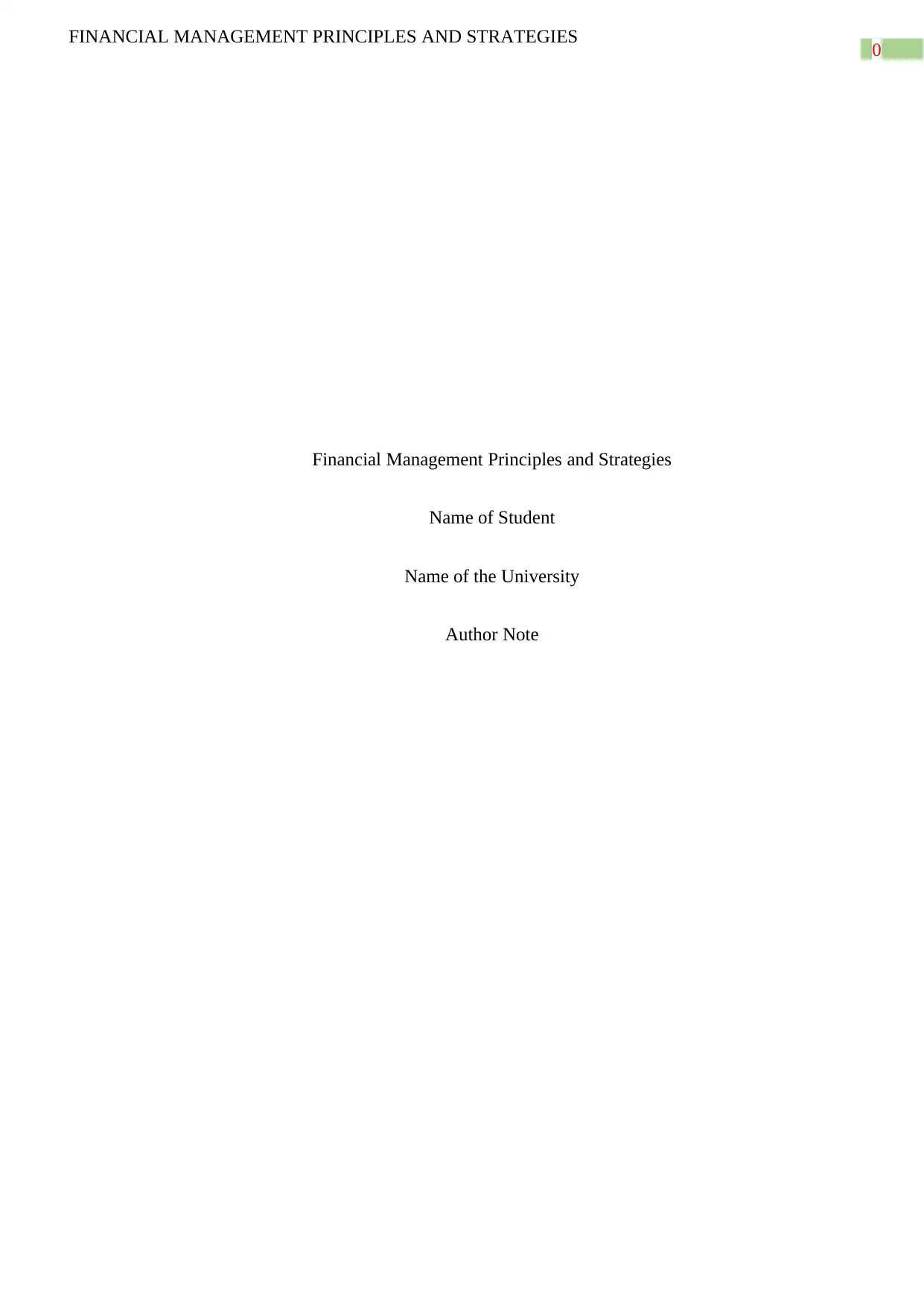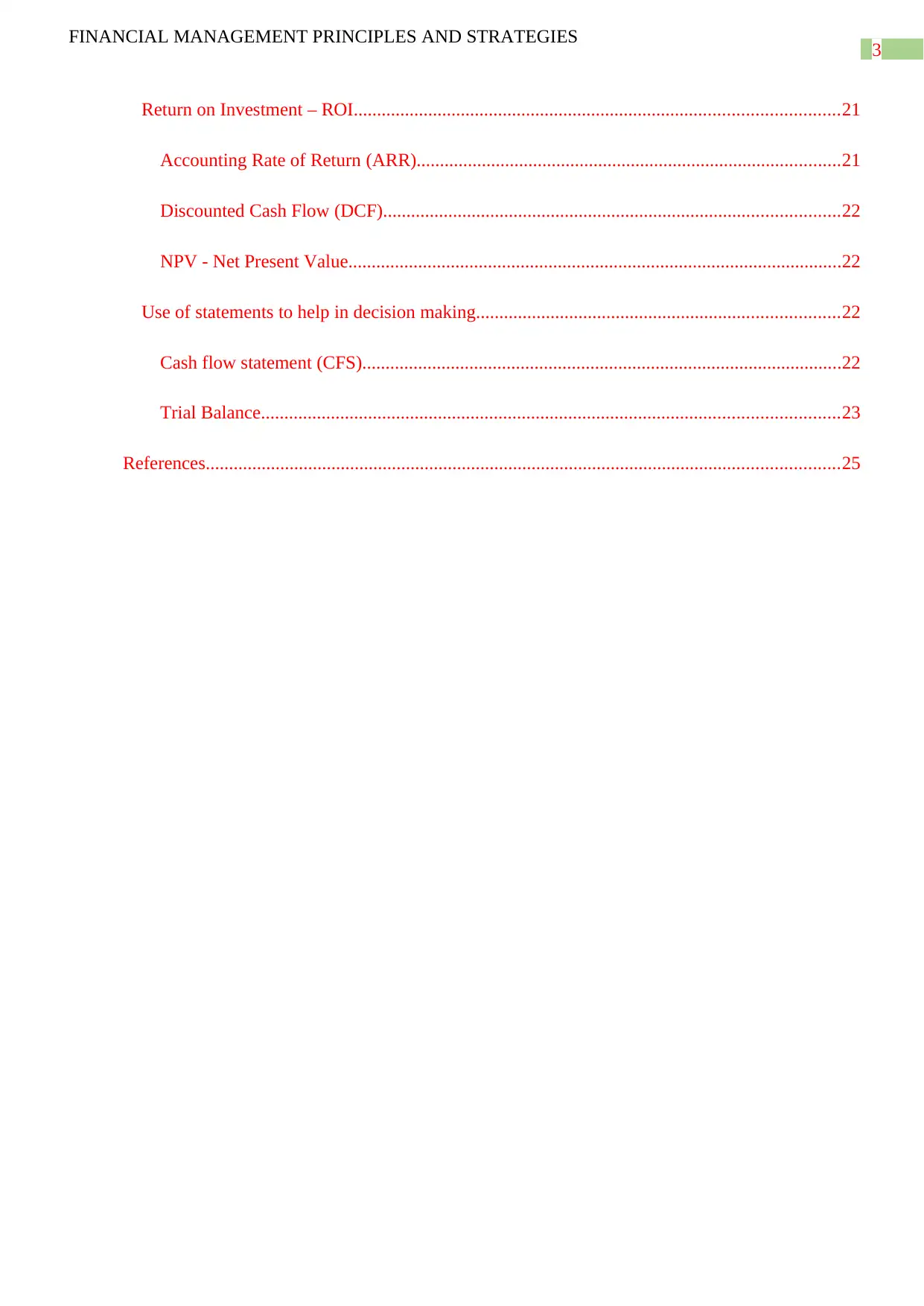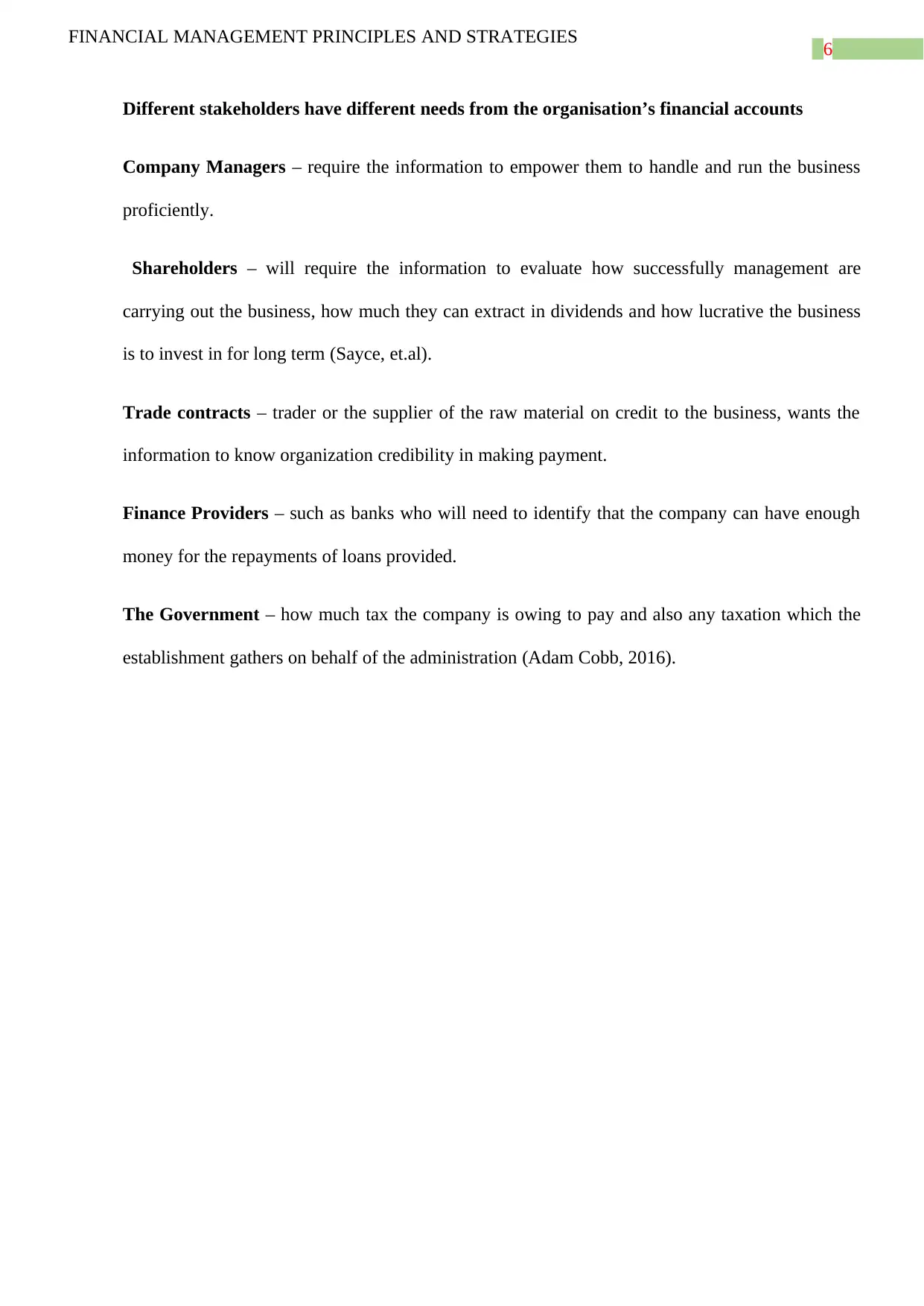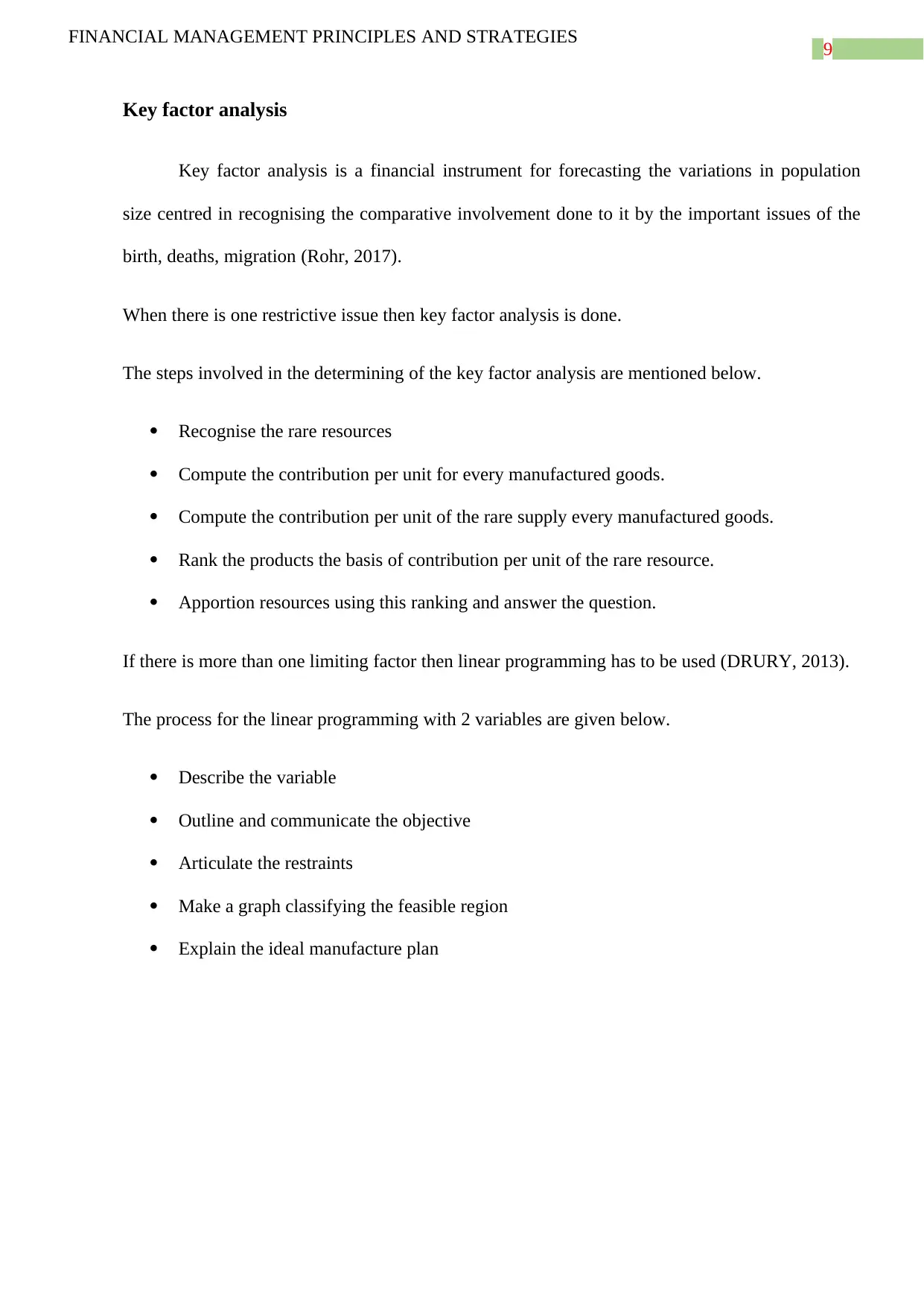Financial Management Principles and Strategies Report - HND Business
VerifiedAdded on 2023/01/16
|32
|5493
|46
Report
AI Summary
This comprehensive report delves into the core principles and strategies of financial management, covering a wide array of topics essential for effective decision-making and sustainable business performance. The report begins by exploring different approaches to support decision-making, including knowledge-based systems, and then examines the crucial role of stakeholders in this process, emphasizing the use of tacit knowledge. It analyzes make-or-buy decisions, production constraints, and key factor analysis. The report then transitions to financial management principles, including setting objectives, ethical considerations, and maximizing shareholder wealth. It provides insights into financial ratios, such as earnings per share, return on investment, and dividend yield, while also evaluating the role of management accountants and accounting control systems. The report concludes with an examination of financial decision-making in the context of sustainable performance, including the use of liquidity ratios, net working capital, and discounted cash flow analysis, and how these are used to improve financial statements and aid in decision making.

0
FINANCIAL MANAGEMENT PRINCIPLES AND STRATEGIES
Financial Management Principles and Strategies
Name of Student
Name of the University
Author Note
FINANCIAL MANAGEMENT PRINCIPLES AND STRATEGIES
Financial Management Principles and Strategies
Name of Student
Name of the University
Author Note
Paraphrase This Document
Need a fresh take? Get an instant paraphrase of this document with our AI Paraphraser

1
FINANCIAL MANAGEMENT PRINCIPLES AND STRATEGIES
FINANCIAL MANAGEMENT PRINCIPLES AND STRATEGIES

2
FINANCIAL MANAGEMENT PRINCIPLES AND STRATEGIES
Table of Contents
Answer to Learning Outcome 1.........................................................................................................4
Different Approaches to Support Effective Decision Making.......................................................4
The role of stakeholder in decision making using the knowledge tacit knowledge.......................5
Make or Buy Decision....................................................................................................................7
Different production constraint that prevent the sale and growth maximization...........................8
Key factor analysis.........................................................................................................................9
Answer to learning outcome 2..........................................................................................................11
Financial management principle which are used for effective of management of strategy.........11
Ethical Financial Management:....................................................................................................13
Maximizing shareholder wealth...................................................................................................13
Suggested improvements to reduce costs, enhance value and quality.........................................15
Answer to Learning outcome 3........................................................................................................17
Evaluation of the role of the management accountant and the accounting control system..........17
Important function of the management accountant......................................................................17
Role of Auditing in Business management..................................................................................18
Answer to learning outcome 4..........................................................................................................19
Financial Decision in the Sustainable performance.....................................................................19
Liquidity ratio...............................................................................................................................19
Net Working Capital................................................................................................................20
Current ratio.............................................................................................................................20
The Acid Test ratio...................................................................................................................21
FINANCIAL MANAGEMENT PRINCIPLES AND STRATEGIES
Table of Contents
Answer to Learning Outcome 1.........................................................................................................4
Different Approaches to Support Effective Decision Making.......................................................4
The role of stakeholder in decision making using the knowledge tacit knowledge.......................5
Make or Buy Decision....................................................................................................................7
Different production constraint that prevent the sale and growth maximization...........................8
Key factor analysis.........................................................................................................................9
Answer to learning outcome 2..........................................................................................................11
Financial management principle which are used for effective of management of strategy.........11
Ethical Financial Management:....................................................................................................13
Maximizing shareholder wealth...................................................................................................13
Suggested improvements to reduce costs, enhance value and quality.........................................15
Answer to Learning outcome 3........................................................................................................17
Evaluation of the role of the management accountant and the accounting control system..........17
Important function of the management accountant......................................................................17
Role of Auditing in Business management..................................................................................18
Answer to learning outcome 4..........................................................................................................19
Financial Decision in the Sustainable performance.....................................................................19
Liquidity ratio...............................................................................................................................19
Net Working Capital................................................................................................................20
Current ratio.............................................................................................................................20
The Acid Test ratio...................................................................................................................21
⊘ This is a preview!⊘
Do you want full access?
Subscribe today to unlock all pages.

Trusted by 1+ million students worldwide

3
FINANCIAL MANAGEMENT PRINCIPLES AND STRATEGIES
Return on Investment – ROI........................................................................................................21
Accounting Rate of Return (ARR)...........................................................................................21
Discounted Cash Flow (DCF)..................................................................................................22
NPV - Net Present Value..........................................................................................................22
Use of statements to help in decision making..............................................................................22
Cash flow statement (CFS).......................................................................................................22
Trial Balance............................................................................................................................23
References........................................................................................................................................25
FINANCIAL MANAGEMENT PRINCIPLES AND STRATEGIES
Return on Investment – ROI........................................................................................................21
Accounting Rate of Return (ARR)...........................................................................................21
Discounted Cash Flow (DCF)..................................................................................................22
NPV - Net Present Value..........................................................................................................22
Use of statements to help in decision making..............................................................................22
Cash flow statement (CFS).......................................................................................................22
Trial Balance............................................................................................................................23
References........................................................................................................................................25
Paraphrase This Document
Need a fresh take? Get an instant paraphrase of this document with our AI Paraphraser

4
FINANCIAL MANAGEMENT PRINCIPLES AND STRATEGIES
Answer to Learning Outcome 1
Different Approaches to Support Effective Decision Making.
A knowledge-based structure is a method of artificial intelligence that targets to
apprehension the understanding of human experts to backing decision-making. Instances of
knowledge-built systems comprise expert system, which are so named because of their trust on
human proficiency (Santoro, et.al, 2018).
The knowledge base comprises a group of information in a specified arena - therapeutic
analysis, for instance. The inference device assumes understandings from the information kept in
the knowledge base. Knowledge-based structures also contain an edge through which users
question the technology and intermingle with it (Dalkir, 2013.).
Knowledge management system are of two types -Explicit knowledge and implicit knowledge.
Explicit knowledge (also called communicative knowledge) is Knowledge that can be
instantly expressed, organised, retrieved and put into words. It can be effortlessly conveyed to
others. Maximum forms of explicit knowledge can be kept in a media file. The information
included in Records, manuals, audio visuals are good models of explicit knowledge (Shintani, and
Ellis, 2013).
Tacit knowledge is the form of Knowledge that is hard to transmit to another person by
medium of inscription or articulating it. However, the capability to speak a language, play a
musical gadget, and use intricate gadget necessitates all kinds of knowledge that is not always
recognised explicitly, even by expert practitioners. The procedure of converting tacit knowledge
into explicit knowledge is identified as codification, articulation. The tacit features of knowledge
are those that cannot be codified, but can only be communicated by training or individual
experience (Rebuschat, 2013).
FINANCIAL MANAGEMENT PRINCIPLES AND STRATEGIES
Answer to Learning Outcome 1
Different Approaches to Support Effective Decision Making.
A knowledge-based structure is a method of artificial intelligence that targets to
apprehension the understanding of human experts to backing decision-making. Instances of
knowledge-built systems comprise expert system, which are so named because of their trust on
human proficiency (Santoro, et.al, 2018).
The knowledge base comprises a group of information in a specified arena - therapeutic
analysis, for instance. The inference device assumes understandings from the information kept in
the knowledge base. Knowledge-based structures also contain an edge through which users
question the technology and intermingle with it (Dalkir, 2013.).
Knowledge management system are of two types -Explicit knowledge and implicit knowledge.
Explicit knowledge (also called communicative knowledge) is Knowledge that can be
instantly expressed, organised, retrieved and put into words. It can be effortlessly conveyed to
others. Maximum forms of explicit knowledge can be kept in a media file. The information
included in Records, manuals, audio visuals are good models of explicit knowledge (Shintani, and
Ellis, 2013).
Tacit knowledge is the form of Knowledge that is hard to transmit to another person by
medium of inscription or articulating it. However, the capability to speak a language, play a
musical gadget, and use intricate gadget necessitates all kinds of knowledge that is not always
recognised explicitly, even by expert practitioners. The procedure of converting tacit knowledge
into explicit knowledge is identified as codification, articulation. The tacit features of knowledge
are those that cannot be codified, but can only be communicated by training or individual
experience (Rebuschat, 2013).

5
FINANCIAL MANAGEMENT PRINCIPLES AND STRATEGIES
Tacit knowledge can be distinguished from explicit Knowledge in three major
areas:
Process of transferring knowledge
Explicit knowledge can be organised and effortlessly transferred, tacit knowledge is
spontaneous and unarticulated knowledge that cannot be communicated, understood without the
acquainting subject'. Unlike the transfer of explicit knowledge, the transfer of tacit knowledge
requires close interaction and the build-up of shared understanding and trust (Yang, Wang and Jin
2014).
Acquisition and accumulation methodology
Explicit knowledge can be created through rational inference and learned by practical
understanding in the applicable framework. On the other hand, tacit information can only be learnt
through applied involvement in the applicable framework.
Possible combination and methods of annexation
Explicit knowledge can be gathered at a particular place, kept in independent arrangements
and adopted without the involvement of the subject. Tacit knowledge on one side, is individual
circumstantial. It is distributive, and cannot simply be accumulated.
The role of stakeholder in decision making using the knowledge tacit knowledge.
Financial statistics is used by a variety of investors, this information therefore, wants to be
truthful to help, and to conform to legislation. Financial information has to follow a severe
auditing procedure. The figures of the financial data therefore, has to be correct, trustworthy, up-
to-date and comprehensible (Trianni, Cagno, and Farné ,2016.).
FINANCIAL MANAGEMENT PRINCIPLES AND STRATEGIES
Tacit knowledge can be distinguished from explicit Knowledge in three major
areas:
Process of transferring knowledge
Explicit knowledge can be organised and effortlessly transferred, tacit knowledge is
spontaneous and unarticulated knowledge that cannot be communicated, understood without the
acquainting subject'. Unlike the transfer of explicit knowledge, the transfer of tacit knowledge
requires close interaction and the build-up of shared understanding and trust (Yang, Wang and Jin
2014).
Acquisition and accumulation methodology
Explicit knowledge can be created through rational inference and learned by practical
understanding in the applicable framework. On the other hand, tacit information can only be learnt
through applied involvement in the applicable framework.
Possible combination and methods of annexation
Explicit knowledge can be gathered at a particular place, kept in independent arrangements
and adopted without the involvement of the subject. Tacit knowledge on one side, is individual
circumstantial. It is distributive, and cannot simply be accumulated.
The role of stakeholder in decision making using the knowledge tacit knowledge.
Financial statistics is used by a variety of investors, this information therefore, wants to be
truthful to help, and to conform to legislation. Financial information has to follow a severe
auditing procedure. The figures of the financial data therefore, has to be correct, trustworthy, up-
to-date and comprehensible (Trianni, Cagno, and Farné ,2016.).
⊘ This is a preview!⊘
Do you want full access?
Subscribe today to unlock all pages.

Trusted by 1+ million students worldwide

6
FINANCIAL MANAGEMENT PRINCIPLES AND STRATEGIES
Different stakeholders have different needs from the organisation’s financial accounts
Company Managers – require the information to empower them to handle and run the business
proficiently.
Shareholders – will require the information to evaluate how successfully management are
carrying out the business, how much they can extract in dividends and how lucrative the business
is to invest in for long term (Sayce, et.al).
Trade contracts – trader or the supplier of the raw material on credit to the business, wants the
information to know organization credibility in making payment.
Finance Providers – such as banks who will need to identify that the company can have enough
money for the repayments of loans provided.
The Government – how much tax the company is owing to pay and also any taxation which the
establishment gathers on behalf of the administration (Adam Cobb, 2016).
FINANCIAL MANAGEMENT PRINCIPLES AND STRATEGIES
Different stakeholders have different needs from the organisation’s financial accounts
Company Managers – require the information to empower them to handle and run the business
proficiently.
Shareholders – will require the information to evaluate how successfully management are
carrying out the business, how much they can extract in dividends and how lucrative the business
is to invest in for long term (Sayce, et.al).
Trade contracts – trader or the supplier of the raw material on credit to the business, wants the
information to know organization credibility in making payment.
Finance Providers – such as banks who will need to identify that the company can have enough
money for the repayments of loans provided.
The Government – how much tax the company is owing to pay and also any taxation which the
establishment gathers on behalf of the administration (Adam Cobb, 2016).
Paraphrase This Document
Need a fresh take? Get an instant paraphrase of this document with our AI Paraphraser

7
FINANCIAL MANAGEMENT PRINCIPLES AND STRATEGIES
Make or Buy Decision
When creating this decision a variety of investigation require to be considered comprising both
quantitative and qualitative foundations (Jami, and Walsh, 2014).
Martin (2015) has charted a variety of features to consider within this decision making procedure
(cost/benefit examination):
Cost Budget factor
Enhanced quality control
competent suppliers
production supply
project strategy secrecy is essential to defend proprietary technology
Minimum Expenses on transportation and warehousing
Governmental, environmental, or societal reasons
Productive use of surplus plant capability to support appropriation fixed overhead
Factors supporting purchase from outside
Third party expertise in productivity, know-how and quality are more than that of the buyer
Deficiency of expertise in –house production
Lesser-volume requirements
Budget aspects (costs fewer to buy the item)
No need to plan a separate strategy for the item.
Costs for the make analysis
Direct labour overhead
Progressive inventory-carrying cost
FINANCIAL MANAGEMENT PRINCIPLES AND STRATEGIES
Make or Buy Decision
When creating this decision a variety of investigation require to be considered comprising both
quantitative and qualitative foundations (Jami, and Walsh, 2014).
Martin (2015) has charted a variety of features to consider within this decision making procedure
(cost/benefit examination):
Cost Budget factor
Enhanced quality control
competent suppliers
production supply
project strategy secrecy is essential to defend proprietary technology
Minimum Expenses on transportation and warehousing
Governmental, environmental, or societal reasons
Productive use of surplus plant capability to support appropriation fixed overhead
Factors supporting purchase from outside
Third party expertise in productivity, know-how and quality are more than that of the buyer
Deficiency of expertise in –house production
Lesser-volume requirements
Budget aspects (costs fewer to buy the item)
No need to plan a separate strategy for the item.
Costs for the make analysis
Direct labour overhead
Progressive inventory-carrying cost

8
FINANCIAL MANAGEMENT PRINCIPLES AND STRATEGIES
Additional capital cost
high purchasing cost
Increased factory running cost
Increased managerial cost
Increased purchased material cost
Cost factors for the buy analysis
Carriage expenditures
Increased buying expenditures
Inspection expenses involved in examining the third product quality
Associated expenses with product quality
Different production constraint that prevent the sale and growth maximization.
Capacity constraints
This happens when the business’s operations uncover an absence of ability to fulfill
demand for its products and services in the market. If this restraint is existent, the urgency is to
abolish it so that more capacity will be can be used (Renz, 2016).
Market constraint.
There is a market constriction if the company has more than adequate production
capability, but there is not sufficient demand in the economy to convert into sales and, ultimately,
profit (Carroll, and Buchholtz, 2014).
Cash constraint.
Complications in cash flow are also measured as constriction, when they could mean an
incompetence on the part of company to pay for its working capital needs (Boatright, 2013).
FINANCIAL MANAGEMENT PRINCIPLES AND STRATEGIES
Additional capital cost
high purchasing cost
Increased factory running cost
Increased managerial cost
Increased purchased material cost
Cost factors for the buy analysis
Carriage expenditures
Increased buying expenditures
Inspection expenses involved in examining the third product quality
Associated expenses with product quality
Different production constraint that prevent the sale and growth maximization.
Capacity constraints
This happens when the business’s operations uncover an absence of ability to fulfill
demand for its products and services in the market. If this restraint is existent, the urgency is to
abolish it so that more capacity will be can be used (Renz, 2016).
Market constraint.
There is a market constriction if the company has more than adequate production
capability, but there is not sufficient demand in the economy to convert into sales and, ultimately,
profit (Carroll, and Buchholtz, 2014).
Cash constraint.
Complications in cash flow are also measured as constriction, when they could mean an
incompetence on the part of company to pay for its working capital needs (Boatright, 2013).
⊘ This is a preview!⊘
Do you want full access?
Subscribe today to unlock all pages.

Trusted by 1+ million students worldwide

9
FINANCIAL MANAGEMENT PRINCIPLES AND STRATEGIES
Key factor analysis
Key factor analysis is a financial instrument for forecasting the variations in population
size centred in recognising the comparative involvement done to it by the important issues of the
birth, deaths, migration (Rohr, 2017).
When there is one restrictive issue then key factor analysis is done.
The steps involved in the determining of the key factor analysis are mentioned below.
Recognise the rare resources
Compute the contribution per unit for every manufactured goods.
Compute the contribution per unit of the rare supply every manufactured goods.
Rank the products the basis of contribution per unit of the rare resource.
Apportion resources using this ranking and answer the question.
If there is more than one limiting factor then linear programming has to be used (DRURY, 2013).
The process for the linear programming with 2 variables are given below.
Describe the variable
Outline and communicate the objective
Articulate the restraints
Make a graph classifying the feasible region
Explain the ideal manufacture plan
FINANCIAL MANAGEMENT PRINCIPLES AND STRATEGIES
Key factor analysis
Key factor analysis is a financial instrument for forecasting the variations in population
size centred in recognising the comparative involvement done to it by the important issues of the
birth, deaths, migration (Rohr, 2017).
When there is one restrictive issue then key factor analysis is done.
The steps involved in the determining of the key factor analysis are mentioned below.
Recognise the rare resources
Compute the contribution per unit for every manufactured goods.
Compute the contribution per unit of the rare supply every manufactured goods.
Rank the products the basis of contribution per unit of the rare resource.
Apportion resources using this ranking and answer the question.
If there is more than one limiting factor then linear programming has to be used (DRURY, 2013).
The process for the linear programming with 2 variables are given below.
Describe the variable
Outline and communicate the objective
Articulate the restraints
Make a graph classifying the feasible region
Explain the ideal manufacture plan
Paraphrase This Document
Need a fresh take? Get an instant paraphrase of this document with our AI Paraphraser

10
FINANCIAL MANAGEMENT PRINCIPLES AND STRATEGIES
FINANCIAL MANAGEMENT PRINCIPLES AND STRATEGIES

11FINANCIAL MANAGEMENT PRINCIPLES AND STRATEGIES
Answer to learning outcome 2
Financial management principle which are used for effective of management of
strategy
Generally, the financial management planning process concludes in the formulation of
corporate strategy. The strength of the entire process of strategic planning is tested by the efficacy
of the strategy finally forged by the firm. Corporate strategy is the game plan that actually steers
the firm towards success. The degree of aptness of this game plan decides the extent of the firm's
success. That is why formulation of corporate strategy forms the crux of the strategic planning
process (Hilton, and Platt, 2013).
Setting objectives to achieve financial goals
Objectives are the expected end result of sequencers of activity, and therefore have a main
part in strategy preparation. Objectives should always be specified as concise as possible, so that it
can quantity whether objectives have been realised (Otley, 2016).
Objectives have many purposes.
They empower the total objectives of the organisation to be fragmented into clear
announcements of what require to be done at every level.
They deliver clear declarations of what action require to be taken.
They deliver an emphasis for every activity.
They offer goals for both personal and group accomplishment.
They simplify the control of authentic performance.
They deliver a ground for assessing how effectively the plans are being executed.
Setting Corporate Objectives
Corporate objectives should communicate those factors that decide an organisation's success.
These include.
Answer to learning outcome 2
Financial management principle which are used for effective of management of
strategy
Generally, the financial management planning process concludes in the formulation of
corporate strategy. The strength of the entire process of strategic planning is tested by the efficacy
of the strategy finally forged by the firm. Corporate strategy is the game plan that actually steers
the firm towards success. The degree of aptness of this game plan decides the extent of the firm's
success. That is why formulation of corporate strategy forms the crux of the strategic planning
process (Hilton, and Platt, 2013).
Setting objectives to achieve financial goals
Objectives are the expected end result of sequencers of activity, and therefore have a main
part in strategy preparation. Objectives should always be specified as concise as possible, so that it
can quantity whether objectives have been realised (Otley, 2016).
Objectives have many purposes.
They empower the total objectives of the organisation to be fragmented into clear
announcements of what require to be done at every level.
They deliver clear declarations of what action require to be taken.
They deliver an emphasis for every activity.
They offer goals for both personal and group accomplishment.
They simplify the control of authentic performance.
They deliver a ground for assessing how effectively the plans are being executed.
Setting Corporate Objectives
Corporate objectives should communicate those factors that decide an organisation's success.
These include.
⊘ This is a preview!⊘
Do you want full access?
Subscribe today to unlock all pages.

Trusted by 1+ million students worldwide
1 out of 32
Related Documents
Your All-in-One AI-Powered Toolkit for Academic Success.
+13062052269
info@desklib.com
Available 24*7 on WhatsApp / Email
![[object Object]](/_next/static/media/star-bottom.7253800d.svg)
Unlock your academic potential
Copyright © 2020–2025 A2Z Services. All Rights Reserved. Developed and managed by ZUCOL.





